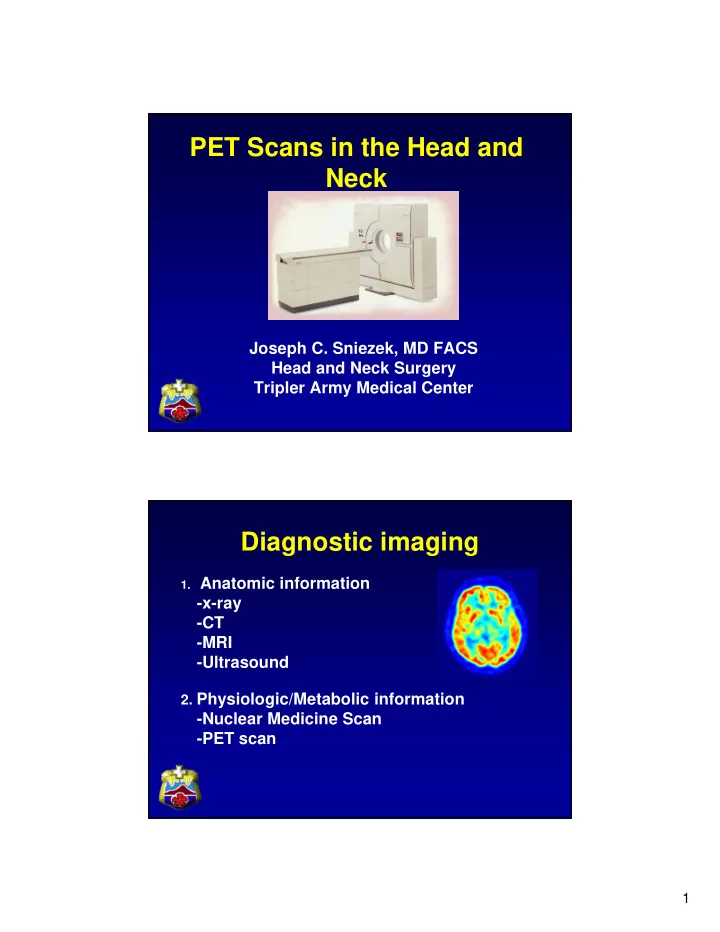

PET Scans in the Head and Neck Joseph C. Sniezek, MD FACS Head and Neck Surgery Tripler Army Medical Center Diagnostic imaging 1. Anatomic information -x-ray -CT -MRI -Ultrasound 2. Physiologic/Metabolic information -Nuclear Medicine Scan -PET scan 1
PET Scans • Utilize P ositron- E mitting radiopharmaceuticals to map the in vivo physiology of the human body • produces T omographic images of function rather than form PET Scan for Surgeons • Nuclear medicine scan • Principle- tumors are hypermetabolic, so glucose uptake high • 8 hour fast 18 fluorodeoxyglucose • (FDG) injected • 1 hour wait • Scan • Fuse/overlay with CT 2
Information from a PET scan 1. Pictorial information (subjective reading) PET Dedicated PET PET/CT Information from a PET scan 2. Objective numerical evaluation – standard uptake value (SUV) • Challenge with PET is that inflamed tissue also takes up FDG • Must differentiate tumor vs. inflammation • SUV is a measure of uptake “intensity” • SUV > 2.4 is suspicious for malignancy, SUV < 2.4 likely inflammatory • Clinical background/timing important • 3
PET Scan Background • Cost- $3,400 • PET/CT- $4,800 • Availability variable • Emerging technology • Interesting research tool • Clinically useful? When should I order a PET scan? 1. Evaluation of the primary 2. Evaluation of the N0 neck 3. Unknown primary 4. Distant mets 5. Tumor surveillance 6. Residual nodal abnormality post chemo/XRT 7. Thyroid cancer 8. PET/CT fusion 4
1. Evaluation of the known primary • No advantage over CT/MRI • Insufficient anatomic detail • Does not change treatment plan • No real role Arch Otolaryngol Head Neck Surg 2012;138(8) 2. Evaluation of the NO neck • Can PET help me decide when to operate on an N0 neck? • PET only detects tumors > 5-10 mm • Malignant nodes > 5-10 mm can be seen on CT or MRI or ultrasound • Treatment plan not altered by PET Head and Neck 2009; 31(3) 5
3. Unknown primary • Unknown primary represents 5-10% of cases presenting with SCC in isolated LN • Pt with 4 cm left node (SCC), negative exam and panendo (1.2 cm SCC found in left tonsil) CT CT PET (4 cm left LN) (nl oropharynx) (pos L neck and OP) Problem- false negatives • Pt with 2.5 cm right JD lymph node positive for SCC on FNA • CT oropharynx normal, PET only shows right nodal uptake • Panendo- 2 mm occult right tonsillar carcinoma CT CT (neg) PET 6
Unknown Primary • Detection rate of occult primary only 25-30% • Sensitivity of PET only 66% in unknown primary • Negative PET does NOT preclude need for careful panendoscopy with directed biopsies Eur Arch Otorhinolaryngol 2010;267(11) • PET only detects lesions > 5-10 mm Miller et al. Curr Onc Reports 2007; 9(2) Journal of Oncology ( 2009); 1-13 . 4. Distant Metastasis • PET much more effective in identifying distant disease than CT -study of 12 pts stage III/IV SCC H&N -PET- found distant disease in 25% CT- 8% Teknos et al Head Neck 2001;23 • PET 100% sens with 85% PPV in benign vs. malig. lung lesions J of Nucl Med 2007; 48(10) Arch Otolaryngol Head Neck Surg 2012;138(8 7
5. Tumor Surveillance (pt follow- up) • Following H&N pts difficult -physical exam affected by scarring -radiographic changes due to XRT • PET 82-95% accurate in differentiating recurrent Ca from radiation changes • CT & MRI only 45-66% accurate J Nucl Med 2009; 50(1) Example • Pt 9 mo. s/p excision left FOM tumor with pain • Normal exam, CT with only operative changes, PET diagnostic of recurrence Nl CT PET PET/CT 8
Timing • Most recurrences occur within 24 months of therapy • PET should be performed no sooner than 12 weeks after surgery +/- chemo/XRT due to inflammation • Timing controversial • I order PET at 1 year post-rx or sooner if suspicious (sens 100%, NPV 100%) J Nucl Med 2009; 50(1) 6. Residual nodal abnormalities After chemo/XRT what do abnormal LN’s on CT mean? -Lavertu data- does pathologic disease mean clinical failure? 9
6. Resid. Nodal abnormal. • 112 pts, compl resp at primary site • PET/CT at 12 weeks post-treatment • + PET had ND, - PET observed • 50 pts had residual CT abnormal (41 PET -, 9 PET +) • 7/9 PET + pts had residual disease • NO PET - PATIENTS FAILED 7. Thyroid cancer • Pts with high TG, but neg WBS difficult • Cause- de-differentiated thyroid cancer cells lack ability to concentrate iodine • PET 82% sensitive in pts with negative I-131 scans • Higher TSH increases FDG uptake, so TSH stimulation should be used with PET 10
8. PET/CT • PET/CT superior to PET or CT alone in diagnosing recurrent H&N cancer (Univ. node Pittsburgh) Pharynx? • PET/CT 98% sensitive, 92% specific (inflammation, infection, etc) Head and Neck 2011; 33:87-94 Take-away points 1. Local disease follow-up- H&N PET has PPV of only 64-90%, NPV of 97% 2. Negative PET in H&N is highly reliable, positive PET is not due to high false-positivity 3. PET very helpful in pt f/u at 1 yr (radiation changes vs. recurrence) 4. PET very good at finding distant mets 5. PET very helpful in thyroid disease Head & Neck 2011; 14(Jan) 11
When should I order a PET scan? 1. Evaluation of the primary 2. Evaluation of the N0 neck 3. Unknown primary 4. Distant mets 5. Tumor surveillance 6. Timing- (min 3 months post-rx) 7. Post chemo/XRT? 8. Thyroid cancer- (high TG, neg WBS) Mahalo 12
Recommend
More recommend